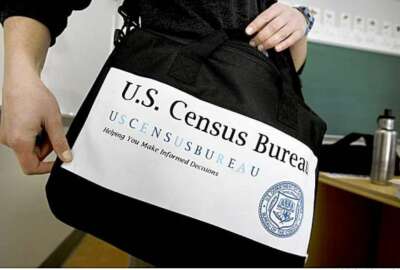
House lawmakers: Census Bureau’s delayed status report ‘unacceptable’
Members of the House Oversight and Government Reform Committee say they're less than certain the Census Bureau's new information technology systems will pass th...
This April marks a sink-or-swim moment for the Census Bureau as it prepares for its first — and only — full-scale field test for the 2020 population count.
But members of the House Oversight and Government Reform Committee say they’re less than certain the Census Bureau’s new information technology systems will pass the muster of the field test.
Part of the problem, the representatives told Acting Census Bureau Director Ron Jarmin, a career federal official, is that the agency has failed to respond to lawmakers’ questions about the state of the new IT systems being tested for the 2020 count.
Nearly three months past the deadline to respond to the committee’s first letter of inquiry, committee Chairman Trey Gowdy (R-S.C.) and Reps. Mark Meadows (R-N.C.) and Gerry Connolly (D-Va.) have sent the Census Bureau a second letter expressing their concerns.
“The Bureau’s failure to respond to the Committee’s request is unacceptable. Provide the requested documents and information immediately,” the congressmen wrote in a Feb. 20 letter to Jarmin.
After sending the first letter on Nov. 21, 2017, the congressmen said they’ve followed up with the Census Bureau several times to no avail.
“On Feb. 1, 2018, in an email exchange with the Bureau, our staff was told the letter was going through the clearance process. In addition, our staff has had no less than three phone calls where the response to this letter was discussed in the past six weeks,” the committee members wrote.
Earlier in the planning cycle, the Census Bureau planned for two other full-scale tests this year — in rural West Virginia and suburban Washington state — but scrapped those tests due to budget constraints.
The Providence, Rhode Island, field test this April will be the agency’s only data point in determining whether the new technology gets the go-ahead for the full 2020 count two years later.
“The 2018 test is the final opportunity for Census to field test more than 40 key IT systems prior to the 2020 decennial census, most of which are new to the upcoming decennial census. The 2018 end-to-end test is a key milestone for the 2020 Census,” the lawmakers wrote.
The Government Accountability Office has also expressed concerns about the Census Bureau’s technology rollout and has placed the 2020 count on its list of high-risk programs.
In the month since the November letter, the committee members said they’ve been briefed by GAO about the state of the Census Bureau’s IT systems.
“Those briefings heightened our initial concerns. According to GAO, not only are IT systems for the 2018 test delayed, many will not be properly tested prior to deployment and many key systems, such as fraud detection, will not be available at all during the live 2018 test beginning April 1, 2018,” the lawmakers wrote.
The committee’s most recent letter requests a briefing from the new associate director of the decennial program on recent changes to the decennial programs directorate, especially related to IT system deployment, no later than March 8, when Commerce Secretary Wilbur Ross is expected to testify before the committee about the state of the Census Bureau’s end-to-end testing.
Steve Murdock, a former Census Bureau director under the George W. Bush administration, told Federal News Radio that the 2020 count faces many of the same technical challenges of the 2010 count.
During the 2010 field tests, the agency experimented with giving enumerators handheld electronic devices to record census responses, but ultimately abandoned the project and continued to use paper forms during the full 2010 count.
“The technology really hadn’t developed to the point where they could be used as a major collection mode for the census. The handhelds had numerous problems that made us go back to what had been used in the census for some time. As I understand it, certainly we’re going to see the use of a lot more technology than we did last time,” Murdock said Wednesday.
While Murdock says he has more confidence in the Census Bureau’s ability to test its IT systems now, he added that even if the Census Bureau falls back on paper forms for the 2020 count, the agency will still see the project through to the best of its ability.
“They had to scrap what they were doing with the handhelds and go back to using paper versions [in 2010], but they did it, because they are a consummate set of professionals,” Murdock said.
Copyright © 2024 Federal News Network. All rights reserved. This website is not intended for users located within the European Economic Area.
Jory Heckman is a reporter at Federal News Network covering U.S. Postal Service, IRS, big data and technology issues.
Follow @jheckmanWFED
Related Stories





